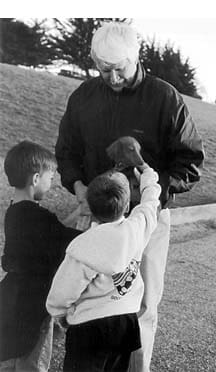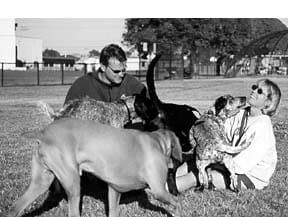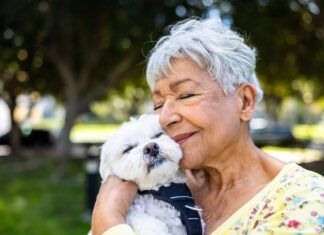Monica and Tess had an inauspicious start in life. Half Rhodesian Ridgeback and half Beagle, at age five weeks they were on display in a cardboard box at a Salinas, California, yard sale, under the ubiquitous “Free to a Good Home” sign.
They were too young to be leaving their mother and siblings, and adopting two puppies at the same time is rarely advisable, but 83-year-old Marie and her dog-loving caretaker, Eleanor, were concerned that the pups might end up in less-than-caring hands, so they scooped the pups up and took them home to their Pebble Beach estate. There, they were assured of regular meals and a secure home, and safe from deliberate cruelty or abandonment.
Unfortunately, that’s not quite everything dogs need in life to thrive in this world. The elderly Marie wasn’t physically able to work with two energetic youngsters, and Eleanor was too busy with her caretaking duties to pay them much attention. The puppies were completely unsocialized to any humans other than the two women, and not very well socialized to them!

By the age of 10 months these puppies were tightly bonded to each other to the exclusion of human relationships. They had never been collared, and would go into a total panic at a hint of restraint. Any quick movements by humans sent them scurrying into the safety of the juniper bushes. They were well past time for spaying, and Marie and Eleanor knew they had to get them to the veterinary hospital for vaccinations and surgery soon. But how, when they couldn’t be restrained or walked on a leash?
They’ve got to be taught
Dogs aren’t born full-fledged “man’s best friends.” As with all baby animals, there is a period of time in their lives when they must learn about the world in order to survive. This critical period is a window of opportunity for socialization – a time when puppies learn what is safe and good and what is not. Opinions differ as to how long the window is open, but it falls somewhere in the period between four and 20 weeks. After the window closes, anything not previously identified as safe will automatically fall into the unsafe category. Dogs must be socialized to the human world during this time, or they will forever be fearful of – or, at the very least, anxious about – new people, sights and sounds.
Dogs who are well-socialized receive lots of gentle human contact and handling from the time their eyes open on into adulthood. Guide Dogs For The Blind and other service dog organizations who must produce the calmest, most socialized dogs possible send their puppies to live with 4-H families, where the participants try to take their service puppies with them everywhere they go. As they get older (eight to 20 weeks) they are given careful exposure to other stimuli, such as visits to the vet hospital and groomer, walks in town, rides on elevators and escalators, sounds of cars, motorcycles and skateboards, people of different ages, sexes, and ethnicities, people who dress, talk and move in strange ways, people with umbrellas, crutches, and wheelchairs.
Proof positive
Have you ever marveled at the ability of service dogs to remain calm and responsive to their handlers’ requests in the midst of a noisy, bustling environment? Then you have witnessed proof that such a thorough, positive exposure to the outside world really does result in a more confident and well-adjusted dog, and one who will easily accept new stimuli, even without prior exposure to that specific experience.
Unfortunately, there are many poorly socialized dogs around us. Some of them, like Monica and Tess, are the result of benevolent neglect – dogs who were never going to go anywhere and whose owners didn’t anticipate the need for them to be socialized (such as routine or emergency medical care, or even emergency rehoming, if something happened to their caregivers).
More unsocialized dogs, however, are ordinary dogs whose owners simply never knew about or bothered with this important aspect of their dog’s care and training, such as dogs who live with elderly people and freak out and bite when the grandchildren visit, or dogs who the ones whose families raise them in the country and then move to the city, where they overreact to the bustle of urban life and the neighbors complain about their incessant barking. An unsocialized dog is a canine social misfit, and a tragic story waiting to happen.
An ounce of prevention
The easiest way to avoid this problem, as with most serious dog behavior challenges, is through prevention. While your veterinarian, concerned about diseases, may caution you against exposing your new puppy to the real world, failure to do so can result in a poorly socialized adult dog. And, in the long term, lack of socialization can be a bigger threat to your puppy’s well-being than the risk of disease.
The answer to this dilemma is to expose a properly-vaccinated (see “Current Thoughts on Shots,” in the August 1999 and September 1999 issues of WDJ) young dog to a controlled social environment. Take her to a well-run puppy class, where she can meet lots of different people and lots of healthy puppies. Invite friends of all ages and races over and have them dress up in odd clothes, hats, umbrellas, sunglasses, etc. Invite children over to play gently with her and to feed her treats.
The more positive encounters a dog experiences while her socialization window is open, the more well-adjusted, confident and gregarious she will be as an adult.
A positive pound of cure
But wait, you say: I’m the owner of an unsocialized adult dog. Don’t despair. Frequently, steps can be taken to make the world a less terrifying place for unsocialized dogs. The quality of their lives can be improved with desensitization, and with training that gives them confidence and helps them make sense of the world around them. It takes a lot of work and a patient owner, but it can be done.

It should come as no surprise that the methods used to rehabilitate an unsocialized dog must be positive ones. The poor pooch is already terrified of the world. Progress is slow in the best of circumstances, and once she starts taking tentative steps to emerge from her shell, the tiniest correction can send her scurrying back to safety. Each dog will progress at her own pace – some far more quickly than others. You must be patient. Pushing an unsocialized dog too quickly can destroy weeks, even months, of painstaking progress.
Here are the steps to take to encourage courage in an unsocialized canine:
1. Teach your dog a bridge, or reward marker. A bridge is a word or a sound that tells your dog that she has earned a reward. The clicker, a small plastic box that makes a clicking sound when pressed, is often used as the bridge in dog training. Your unsocialized dog may be sound sensitive. If so, you may want to start with a one-syllable bridge word, such as “Yes!” instead of the clicker. “Good Dog!” is not a good choice for a reward marker. It’s too long. A dog can do several behaviors during the time it takes to say two syllables. Which one is getting rewarded? Besides, we tend to say “Good dog!” to our dogs all the time just because we love them. We need a marker that only means “a reward is coming.”
To teach your Timid Tess the bridge, just say “Yes!” (or Click! the clicker if she tolerates the sound), and immediately feed her a small but very tasty treat. She doesn’t have to do anything special to get the Yes! and treat at first, but do try to avoid marking and treating if she is doing something you don’t want her to do, like jumping on you.
If Tess is unsocialized even to you and won’t come close enough to eat treats out of your hand you can toss the treats to her at a distance or scatter treats all over the ground, and Yes! or Click! every time she picks one up. Once she knows that the marker means “Treat!” you can, for the rest of her life, click! (or yes!) and treat her every time she does something good; this will reinforce that behavior and increase the likelihood that she will do it again.
2. Reward-mark her entire meal.
Let this be the only way Tess gets to eat – by being in your company and eventually, when she’s brave enough, by eating out of your hand. She needs to learn that you are the source of all good things. Reward-marking won’t work as well for a free-roaming feral dog – she will have access to other food sources and won’t have to tolerate your presence to find food. Please note – we absolutely do not advocate starving a dog in order to get her to take food from you. You will need to find an environment where Tess feels comfortable eating in your presence – if necessary a large enough room or yard that she can be fairly far away from you at first while she picks treats up off the ground and gets marked.
3. Reward-mark her for calm behavior around others. Once Tess knows that the bridge means “Treat!” you can Yes! or Click! and treat anytime she is being brave. If she is normally afraid of children and she sits quietly next to you on a park bench while a child walks by, Yes! and reward. Look for very small, rewardable behaviors. If she glances at a child and doesn’t react, Yes! and reward.
4. Make a list of her fear triggers. You probably have a good idea of what the things are that frighten Tess. These are her “fear triggers.” Make a list, and include everything you can think of. Ask other family members to help. Then prioritize your list. Now decide which trigger you want to start with in her desensitization program. Start with something achievable. For your dog’s sake and for yours, it’s important to have small successes throughout the process. You might need to take a big trigger and figure out how to break it down into smaller pieces.
For example: if her Number 1 Trigger is tall men with beards and cowboy hats, you might start with tall, clean-shaven men. Start leaving cowboy hats around the house in conspicuous places, and occasionally put one on yourself. Other family members and people who are well-liked by Tess can do the same. Once she accepts tall men, you can advance to clean-shaven tall men with cowboy hats. Meanwhile, work at desensitizing her to short men with beards. Then try tall men with beards without cowboy hats. When you have desensitized her to all the of the pieces, then you can finally put them together as tall men with beards wearing cowboy hats.
This takes time and patience. If you skip steps you may undo all of your painstaking training progress and have to start over.
5. Use counter-conditioning and desensitization. Desensitization is the process of gradually acclimating a dog to the things she is afraid of. Counter-conditioning means replacing her undesirable reaction – fear – with a more desirable one that is incompatible with fear, such as the eager anticipation of a tasty treat.
Let’s say Tess is afraid of strangers. Since we can’t control a stranger’s behavior, we need to create a stranger who will work with us. Get a friend to act as your stranger, and brief him ahead of time. Set up a system of simple hand signals so you can let him know if you want him to stay where he is, come closer, go farther away or move to the side. If your dog’s fear threshold is 30 feet – that is, if she starts acting stressed or scared when strangers are 30 feet away, start with your stranger at 35 feet.
You should be sitting comfortably, with Tess on a leash next to you in a controlled environment. You don’t want some real stranger to wander through and mess up your carefully staged training session! While your dog is calm about the stranger’s presence just beyond her threshold, feed her lots of tasty teats. Handfuls!!!! Then have your stranger gradually move closer . . . very gradually . . . a few inches at a time if necessary.
It helps if your “stranger” is talented enough to act natural, not be furtive or suspicious. Also, he should avoid making any eye contact with the dog. A direct stare is a threat in canine body language, and is especially threatening to a dog who is already stressed.
If the dog starts to get nervous at 29 feet, signal the stranger to stop. Feed Tess more treats until she relaxes, and then end the session. Have the stranger walk away (another huge reward for Tess’ good behavior). Schedule another session for the next day. (I told you this could take a long time!) During the second session you might have your stranger move laterally at a distance of 29 feet to vary the experience. If Tess continues to stay relaxed as the stranger moves around and approaches, give her lots of rewards and stop the session at a reasonable distance before she gets stressed. Don’t push it. Success in slow increments is the key. Slow success is far more important than fast progress. You want Tess to know that the presence of strangers makes good things (lots of treats) happen.
NOTE: In order for desensitization and counter conditioning to work you need to be very good at recognizing your dog’s signs of stress. The book On Talking Terms With Dogs: Calming Signals, by author Turid Rugaas, is an excellent resource for learning how to read your dog’s body language signals.
6. Reward-mark while others feed treats. If Tess is more tolerant of people than in the scenario described in Step #2, you can have other people feed her treats when you reward-mark, or they can reward-mark and treat. The ultimate goal is to have Tess believe that people are safe and good, not scary and dangerous. The more she will accept treats from others, the more she can associate them with good things, not just you.
7. Teach her to target. “Targeting” is teaching your dog to touch a target with her nose on cue. It’s easy to do, and it’s a great confidence builder for timid dogs.
To start, hold a target object – such as your hand, a pencil or a short (2-3 foot) dowel – in front of you. Use something that won’t frighten her. When she touches it with her nose, Click! or say Yes! and feed her a treat. (If she won’t touch it, rub a meaty-flavored treat on it so it smells irresistible.) When she is eagerly touching the target, add the cue-word “Touch!” as she does it. Continue to Click! and treat. In short order she will be eager to touch the target when you ask her to.
Dogs love this exercise. It’s like a treat vending machine – they push the button, they get a treat. By placing the target, which they love, near something that they are leery of, you can get them to approach the scary object. When they get clicked and treated for touching the target near the object, they soon decide that the scary thing isn’t so bad.
Don’t ‘protect’ the dog
You must avoid coddling your skittish dog through this process. As tempting as it may be, do not allow yourself to coddle and comfort your Timid Tess. You will be rewarding and reinforcing her timid behavior, not giving her confidence, like you might think. If you act concerned, she will be even more convinced that there is something to be afraid of. You’ll do better to act matter-of-fact, jolly her up and let her know there’s nothing wrong. The target stick works really well in place of coddling.
It’s important to always remember that your unsocialized dog is not acting out of spite or malice. She is truly afraid, even terrified, of the things that she reacts to. Don’t blame her. It’s not her fault. Be patient, and help her to slowly learn that the world is not such a frightening place after all.
Well worth the effort
This process really works. I know it works through numerous personal experiences – as well as from the example of Monica and Tess, the puppy sisters who were taken home from the yard sale and allowed to grow up fairly “wild” on a large estate. When their owners realized that they would never be able to get the puppies to a veterinarian’s office for shots and spaying without professional help, they began calling trainers, and eventually I heard about their plight. I worked with Monica and Tess and their owners in their home. Their progress was slow but very encouraging. At the end of two months, the sister dogs knew the “Yes! and reward” system well. They could sit and lie down on cue, were wearing collars, and were learning to accept the pressure of leash restraint. They had come to enjoy my attentions, and Marie and Eleanor had started inviting more people over, specifically to socialize the dogs. It was working, slowly. Ultimately, Monica and Tess will probably be able to live a reasonably fear-free life in their own home, and will be able to be taken to the vet without causing harm to either themselves or their handlers.






